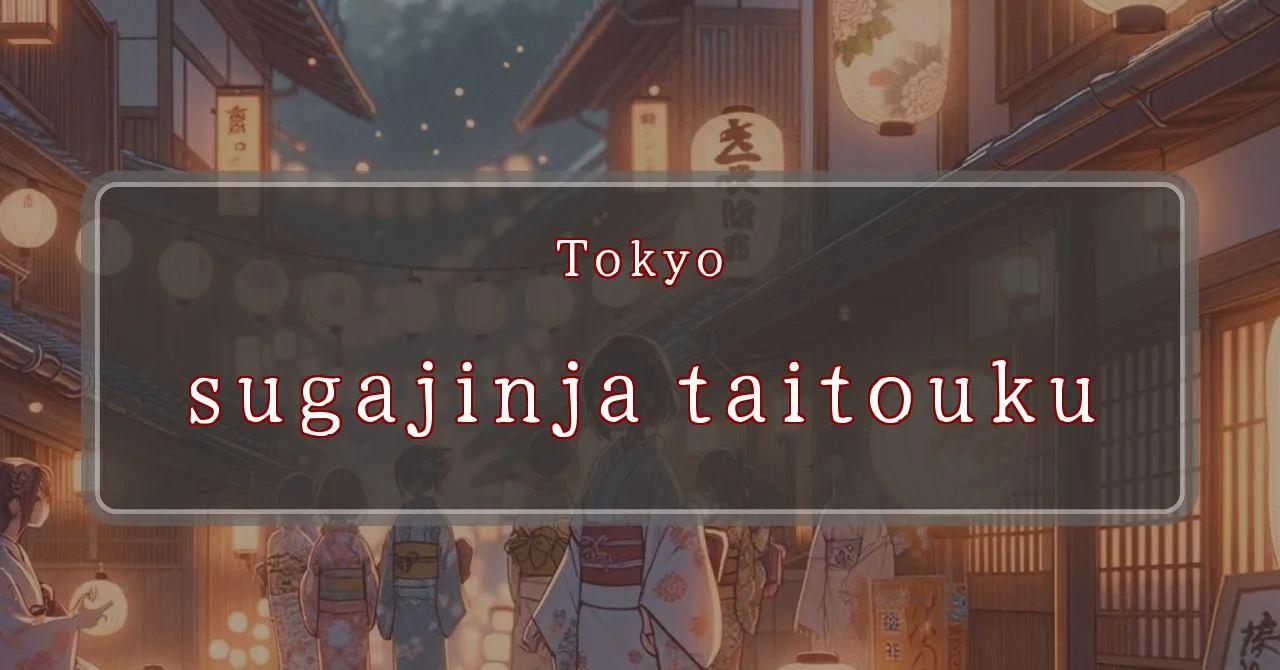Enchanting lights dance at SUGA Shrine, painting the night with vibrant hues.
Basic Information
Uncover the captivating history and vibrant traditions of SUGA Shrine, a sacred site nestled in the heart of Tokyo’s vibrant Asakusa district.
- Address: 2-29-16 Asakusabashi, Taitō-ku, Tokyo 111-0053
- Phone Number: 03-3851-7044
- Access: Embark on a leisurely 3-minute walk from Asakusabashi Station, accessible via the Toei Asakusa Line or JR Sobu Line.
- Festival Days: Immerse yourself in the festivities on June 8th, 2024, as the shrine celebrates its annual grand festival.
Main Events and Attractions of the Festival
Immerse yourself in the vibrant festivities and rich traditions of the SUGA Shrine Festival, held annually in the heart of Tokyo’s Asakusa district.
Mikoshi Procession
Witness the grandeur of the Mikoshi Procession, a captivating spectacle that takes place on the second Sunday of June. Adorned with intricate carvings and vibrant colors, the sacred Mikoshi, or portable shrine, is paraded through the streets, accompanied by lively music and enthusiastic participants.
- Overview: A parade of the sacred Mikoshi, representing the enshrined deity
- Significance: Symbolizes the deity’s visit to various locations, bestowing blessings
- Highlights: Elaborately decorated Mikoshi, traditional music, and energetic participants
Kagura Performance
Be mesmerized by the enchanting Kagura Performance, a traditional sacred dance and music ritual performed by shrine maidens. Dressed in colorful attire, they gracefully move to the rhythm of ancient melodies, invoking the blessings of the gods.
- Overview: A sacred dance and music ritual performed by shrine maidens
- Significance: A dedication to the enshrined deity, expressing gratitude and seeking blessings
- Highlights: Graceful movements, melodious music, and vibrant costumes
O-mikuji Fortune Telling
Seek divine guidance and insights into your future through O-mikuji Fortune Telling. Draw a fortune slip from the designated spot and discover your destiny for the coming year. Whether it’s good luck, prosperity, or a gentle reminder, embrace the wisdom of the gods.
- Overview: Draw a fortune slip to receive guidance and insights into your future
- Significance: A chance to connect with the divine and seek blessings
- Highlights: Variety of fortune slips, ranging from good luck to gentle reminders
Blessings and Deities
At SUGA Shrine, the revered deity enshrined is Susanoo-no-Mikoto, a powerful and enigmatic figure in Japanese mythology. Known for his bravery, strength, and tempestuous nature, Susanoo-no-Mikoto is revered as the god of the sea, storms, and agriculture. Devotees seek his blessings for protection against natural disasters, bountiful harvests, and success in various endeavors.
- Deity Enshrined: Susanoo-no-Mikoto
- Domains: Sea, storms, agriculture
- Blessings Sought: Protection, bountiful harvests, success
Origin and History
The origins of SUGA Shrine are shrouded in mystery, with its history stretching back to ancient times. According to legends, the shrine was initially established during the reign of Emperor Sujin, over two thousand years ago. Throughout the centuries, it has undergone several renovations and expansions, reflecting the enduring faith and devotion of its worshippers.
- Establishment: Emperor Sujin’s reign (over 2,000 years ago)
- Significance: Ancient origins, enduring faith
Tips and Notes for Visitors
To fully immerse yourself in the festivities and experience the sacred atmosphere of SUGA Shrine, here are some tips and notes for visitors:
- Dress respectfully: As a sacred site, visitors are expected to dress modestly and respectfully.
- Observe proper etiquette: When approaching the shrine, perform a slight bow to show reverence.
- Participate in rituals: If you wish, you can participate in traditional rituals such as hand-washing and offering prayers.
- Enjoy the festival: During the annual festival, immerse yourself in the vibrant atmosphere, witness colorful processions, and partake in various cultural activities.
Parking Information
For those arriving by car, limited parking is available near SUGA Shrine. However, it is highly recommended to utilize public transportation or consider alternative parking options in the surrounding area to avoid congestion and ensure a smooth visit.
- Limited parking available near the shrine
- Public transportation or alternative parking options recommended
Popular Stalls and Food Carts in Recent Years
| Type of Stall | Description |
|---|---|
| Takoyaki | A staple at Japanese festivals. Characterized by a crispy outside and a creamy inside. |
| Jaga Butter | A simple yet popular snack of hot potatoes lavishly topped with melted butter. |
| Baby Castella | Small castella cakes, sweet and fluffy treats enjoyed by children and adults alike. |
| Grilled Ayu with Salt | Fresh ayu fish grilled whole with salt, a savory taste of Japanese summer. |
| Shaapin | A unique gourmet item influenced by foreign cuisine, with a chewy skin wrapping the filling. |
| Okonomiyaki | A Japanese grilled dish where you often choose your own ingredients for a personalized flavor. |
| Cotton Candy | A fluffy, sweet snack that’s extremely popular with children. |
| Chocolate Banana | A banana coated in chocolate, a fun and visually appealing dessert. |
| Kushiyaki | Various types of ingredients skewered and grilled, an easy-to-enjoy snack. |
| Yakisoba | Fried noodles mixed with a special sauce, a fast food favorite in Japan. |



